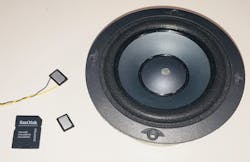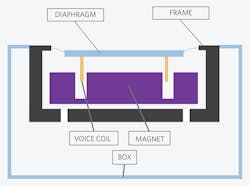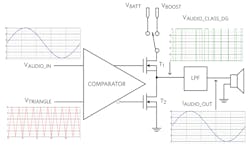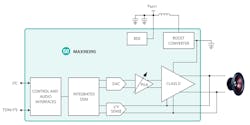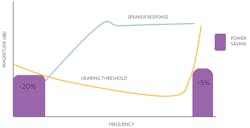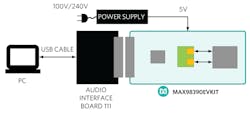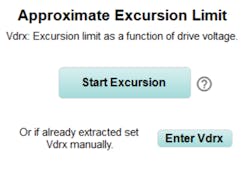Download this article in PDF format.
You’re watching your favorite movie on your tablet, and the sound from the micro speakers comes through with such richness, loudness, and clarity that you almost feel like you’re listening to full-size speakers (Fig. 1). Now you want to deliver this level of audio performance in even smaller devices, such as wearable, medical, augmented/virtual reality (AR/VR), gaming, and smart-home IoT solutions.
1. Delivering powerful sound and long operation in a small package.
The designers outside of the smartphone and tablet markets are looking to leverage the same micro speaker and IV-sense (current and voltage sensing) amplifier technologies for compact designs in a multitude of end markets. However, due to their small size, micro speakers have limited ability to accurately reproduce sound.
Hence, the burden shifts to the audio amplifier, which, through a combination of hardware and software system integration, picks up the slack: It manages to deliver sound quality that turns music lovers’ heads while still minimizing power consumption for longer battery life.
Improving sound quality with IV-sense amplifiers relies on an accurate speaker model to tune the amplification algorithm. Proper speaker characterization is difficult and expensive work that requires extensive expertise and special, expensive equipment.
The limited availability of equipment and expertise for IV-sense amplifiers presents a huge barrier to their proliferation in low-volume applications. This article presents a disruptive approach that removes the characterization barrier with a quick, cost-effective, high-performance solution.
The Micro in Micro Speaker
Micro speakers are diminutive devices that must fit into small portable gadgets like medical wearables, smart-home IoT, and gaming devices. Figure 2 shows the size comparison of two micro speakers (one with wires) next to a SD memory card and a more traditional speaker.
2. Size comparison of micro speakers versus a traditional speaker.
The small size of a micro speaker limits its ability to reproduce sound with high fidelity. Figure 3 illustrates the relationship between a speaker’s size and range of operation.
3. The small size of a micro speaker reduces its bandwidth.
In particular, the small size of a micro speaker also limits its excursion and confines its response to the treble frequency range, producing a tinny audio response. The challenge for the micro-speaker designer is to overcome these limitations. One way is to include integrated boost and digital signal processing (DSP) with an IV-sense audio amplifier. This vastly improves sound quality by increasing loudness (sound pressure level) by 2.5X and significantly extending bass frequency response well past the resonant frequency of a micro speaker.
Micro Speaker Operation
Figure 4 shows the basic elements of a micro speaker’s operation. The voice coil is immersed in the magnetic field established by the permanent magnet. When a variable current (the audio signal) flows into the voice coil, a corresponding variable force is applied to the coil (Lenz’s Law). The diaphragm, attached to the voice coil, vibrates accordingly and produces a sound of amplitude proportional to the diaphragm deviation from the state of rest (this is known as excursion).
4. Shown is a cross-section of a micro speaker.
The micro speaker is encased in a box, which functions to block the bottom half of the sound waves and avoid sound cancellation.
Class DG Amplifier
The key to better portability and longer battery life is to drive a speaker with an audio amplifier that has a switching Class DG architecture (Fig. 5). This option is better as opposed to using a classic linear version, which is notoriously lossy.
5. Synopsis of the Class DG Amplifier Principle.
In Figure 5, the audio signal (VAUDIO_IN) is digitized by the modulator (Comparator + VTRIANGLE), which embeds signal information into the duty cycle of the power output (VAUDIO_CLASS_DG). Finally, the original sound amplified through the power transistors T1 and T2 (IAUDIO_OUT) is recovered by the low-pass filter and applied to the speaker. The Class DG amplifier uses a multilevel output stage to sense the magnitude of the output signal. It then switches the supply rails (VBATT, VBOOST), as needed, to supply the required signal power more efficiently.
Although amplification is its obvious function, at the heart of a modern audio amplifier is a digital signal processor (DSP) that incorporates a micro-speaker protection algorithm. The DSP helps overcome the intrinsic limitations of a micro speaker by extending its response and capabilities.
Pushing the Envelope
In simple terms, micro speakers present several challenges to delivering big sound in a small box. The speaker power-rating limits are determined by the voice-coil thermal limit and the diaphragm excursion mechanical limits. With excessive current flow, the voice coil can get so hot that the mechanical components comprising the voice coil and diaphragm system could melt.
The micro speaker’s small size also limits its capability to produce lower bass frequencies. An increase in bass response can cause an over-excursion event if the response is extended below the resonant frequency, which is quite high (~1 kHz) for these micro speakers. The sound pressure can become so extreme that the diaphragm breaks apart, resulting in what’s known as a blown speaker.
Speaker manufacturers rate their products very conservatively, with a built-in engineering margin to protect against all kinds of abuse. However, the quest for better sound within smaller form factors in products such as smartphones has fueled the race to squeeze more out of a micro speaker. With a combination of speaker parameter characterization and active speaker management during operation, a 1-W speaker can now put out up to 5 W safely.
Currently, this type of performance doesn’t come cheap. For speaker protection to function, the speaker must be characterized, which, as mentioned earlier, requires significant expertise and expensive special equipment. On the performance side, it needs the development and porting of a complex management algorithm. The extracted parameters and the management algorithm are loaded into a DSP, requiring specialized software development that’s unique for different processor cores. This cumbersome process must be repeated many times, since several micro speakers have to be evaluated in order to arrive at a final choice.
Dynamic Speaker Management (DSM)
To simplify the implementation of such a complex technology, Maxim Integrated developed the Dynamic Speaker Management (DSM) smart amplifier solution. DSM significantly increases loudness (SPL) and bass response from micro speakers.
The MAX98390 DSM smart amplifier (Fig. 6) integrates a high-performance IV-sense amplifier and fixed-function DSP loaded with a proven DSM algorithm. The high-efficiency mono smart amplifier also features an integrated boost converter with boost-bypass and high-resolution envelope tracking to maximize battery life, especially at lower output levels. The integrated fixed-function DSP is hard-coded with the DSM algorithm to eliminate the time-consuming programming steps needed with other general-purpose DSP implementations.
6. The MAX98390 Class DG amplifier leverages DSM technology.
With DSM, the speaker performance envelope (Fig. 7) is safely extended upward, increasing the audio volume (+6-8dB SPL). It also goes downward, extending the bass response to a quarter of the resonance frequency (Fc).
7. A deeper bass and more loudness are possible with DSM.
Power Management with DSM
Multiple methods are employed to maximize the audio amplifier’s efficiency. FET scaling at low power reduces switching losses. High-resolution envelope tracking on the boost converter assures that the audio signal headroom is minimized. The boost is also bypassed as soon as possible, always operating the amplifier with the lowest possible power rail.
In addition, integration of Maxim’s Perceptual Power Reduction (PPR) algorithm (Fig. 8) further increases efficiency up to 25% with no loss in audio fidelity. PPR is an adaptive and dynamic filter that uses the human hearing threshold to model what the user would perceive. Based on the speaker’s characterized response, it removes content that would not be audible based on the content and volume level. However, if there’s a case where power savings is more important than audio fidelity (i.e., in a 10% “low-power mode” smartphone option), the PPR threshold can be set more aggressively to trade off some of the bass response in favor of desired audio fidelity and battery life.
8. PPR power savings of up to 25% can be achieved.
DSM Sound Studio
The complexities of parameter extraction, tuning, and evaluation can be eliminated when using the MAX98930 evaluation kit and the DSM Sound Studio GUI. The use of both guides the audio designer from initial design to production (Fig. 9).
9. A simple hardware setup is all that’s required for complete operation of the DSM Sound Studio.
One of the most unique features of the DSM Sound Studio is its ability to quickly evaluate key parameters of multiple speakers (see table).
Speaker parameter extraction is broken down into two main steps. The first step automatically extracts and reports Fc, Q, Re, and Tamb parameters. The second step includes setting thermal and excursion limits. The excursion (Xmax) calibration is performed with an acoustic approximation represented by the amplifier voltage drive (VdrX), necessary for the speaker tone to reach an approximate excursion limit (Fig. 10).
10. Maximum excursion calibration.
The voice-coil thermal limit is normally provided by one of Maxim’s micro-speaker vendors. However, if this value isn’t readily available, we suggest using 80°C as a starting point until the specification is supplied by the micro-speaker vendor.
Once the final speaker is selected, the designer has the option to send it to Maxim for a final verification of its characterization. This final service is included with the purchase of an evaluation kit and is limited to one speaker characterization per evaluation kit purchase. This service includes fine-tuning the VdrX vs. excursion Xmax limits, directly measured with a laser micrometer.
Conclusion
In this design solution, the obstacles to obtain high-quality sound from micro speakers were discussed. Existing solutions rely on complex systems and procedures to model the micro speaker and compensate for deficiencies that are barriers for many designers. Helping to overcome this is Maxim’s DSM Sound Studio GUI, which simplifies design and improves time to market.
Furthermore, there was an examination of Maxim’s DSM Smart Amplifier, which integrates the DSM algorithm into a fixed-function DSP to alleviate the complexities of programming and help minimize quiescent-power consumption. DSM is a fast turnaround system solution, based on the MAX98390 Class DG audio amplifier that significantly increases loudness (SPL) and bass response from micro speakers while boosting efficiency for longer battery operation.
Greg Mow is a Business Manager in the Mobile Audio BU, Michael Tuason is Principal Member of Technical Staff and Audio Applications Engineer, and Nazzareno (Reno) Rossetti is an analog and power-management expert at Maxim Integrated.
MAX98390 Boosted Class-D Amplifier with Integrated Dynamic Speaker Management
Dynamic Speaker Management (DSM)


